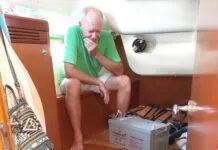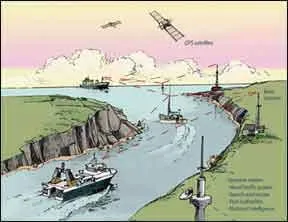Sailors who read George Orwells 1984 when it was first published 62 years ago probably wrote off being tracked as a technological feat that was about as unlikely as the discovery of a tiny black box that would replace the sextant. Six decades later, GPS-based navigation has become de rigueur, and the big question is not if, but how tracking technology will be used. The upside of being locatable 24/7 includes many safety and search-and-rescue benefits. But the intrusive downside goes well beyond its impact on sailings get-away-from-it-all appeal. For many, theres growing concern over the unintended consequences linked to being a very noticeable dot on some trackers grid.
If youre already starting to glaze over, expecting a rambling unfocused diatribe about Big Brother and hyper scrutiny, lets clear the deck and recognize that this isn’t a hypothetical rant about an over-scrutinized citizenry or a whacky treatise on freedom versus security. Its a matter-of-fact look at a system thats already in place and being sold in chandleries, on websites, and via marine catalogs across the country-and its known to us all as AIS.
For some reason, the full role of the Automatic Identification System (AIS) has gone mostly unmentioned. Instead, the technology has been sold to sailors as a must have collision-avoidance aid. For example, the already implemented AIS (Class A version) is a must-carry for vessels over 300 gross tons and certain high-speed yachts. Other craft may install the compatible Class B transceiver and become part of a localized collision-avoidance grid. We have written quite a bit about the systems advantages as an aid to navigation, but up until now, we havent pointed out that the system also represents the foundation for the Department of Homeland Securitys Maritime Common Operating Picture, a vessel-tracking system run by the U.S. Coast Guard and dubbed the National Automatic Identification System (NAIS).
In a recent USCG Acquisition Directorate statement, the goal of Maritime Domain Awareness (MDA) was pretty well defined, and security seemed to top the list of objectives. According to this directorate, AIS data is combined with other government intelligence and surveillance information to form a holistic, over-arching view of maritime traffic…detecting anomalies, monitoring suspicious vessels, and pinpointing the location of potential threats. We have yet to see this verbiage used in any promotional material or sales pitches about AIS. Magazines have been touting the importance of vessel-to-vessel awareness, and we sailors are excited about the systems function as a collision-avoidance tool. But the less-advertised tracking feature also deserves some attention.
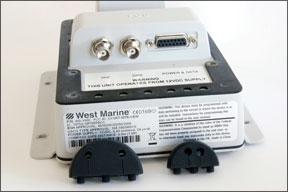
Photos by Al Herum and courtesy of U.S. Coast Guard
The flip side of the AIS coin is its contribution to Maritime Domain Awareness, a capability that comes from a $27 billion investment portfolio that the USCG Acquisition Directorate is handling. NAIS is one of its premier projects, and when fully implemented, it will include satellite surveillance of all AIS signals up to 2,000 miles from the coast, plus monitoring equipment on cutters, data buoys, and offshore platforms. Recently built towers that rim the U.S. coastline are already getting an upgrade in order to track AIS signals as part of the Rescue 21 program, a new, advanced communications system that is replacing obsolete radio comm systems. All this surveillance info will be channeled through a network and shuttled on to control centers. The data will be continuously monitored and kept ready to be passed along to other security agencies. As the architects of the plan put it, Armed with a comprehensive view of our nations waters, decision-makers will be better positioned to respond to safety and security risks. For some, this probably sounds reasonable and reassuring, but for others, theres a little voice in the back of their head saying that it sounds just a little too Orwellian.
Regardless of your vantage point, you might ask the question, Who will be deemed a decision-maker and who will place the suspicious label on a specific vessel and crew? In essence, a sailors Good Samaritan effort to share location data will automatically enroll them in a data bank that tracks all of their movements. And the information could even be used by agencies for which you need a top-secret clearance to find their phone number.
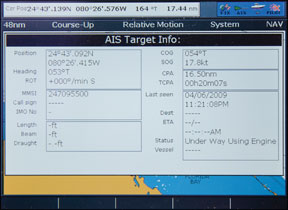
Photos by Al Herum and courtesy of U.S. Coast Guard
In order to present a balanced perspective, Ill paraphrase what Kip Louttit-a friend whos a retired USCG captain, ocean racer, and regular speaker at Safety at Sea seminars-had to say about AIS and the USCGs Rescue 21. Kip has heard both sides of the argument and speaks candidly about whats going on. Hes quick to point out that there is an elevated threat level caused by terrorism around the world, and like it or not, The gun mounts are back on Coast Guard cutters, he says. Port security is a big deal, and knowing who and whats in play in coastal waters is a significant issue. He admits that the average young, capable USCG small-boat coxswain and crew usually have little understanding of whats involved in handing a sailboat-or for that matter, why the sailor isn’t instantly accessible on Channel 16, and why any level-headed adult would stand out in the rain, tugging on lines, when they could have purchased a motorboat with pilot house and a captains chair.
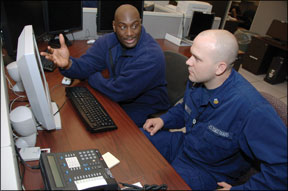
Photos by Al Herum and courtesy of U.S. Coast Guard
When it comes to suspicious actions, checkoffs on the tickler list include non-resident craft arriving from offshore or coastal waters, vessels that appear to be riding low on their lines, craft underway at night with a minimal radar signature, and boats with no deck lighting and only the bare minimum of navigation lights displayed. Unfortunately, we have just described the average cruising sailboat, and the question is, Will AIS data eliminate or escalate suspicion? Theoretically, a quick check of the linked Homeland Security Database will reveal who owns the boat, and (hopefully) their lack of a criminal record, their standing as a good taxpayer, and perhaps even their travel history. However, if you happen to be like my 9-year-old grandson, who has the same name as someone on the TSA security watchlist, you too may be cornered by agents and put through a nautical, rather than airport, ringer.
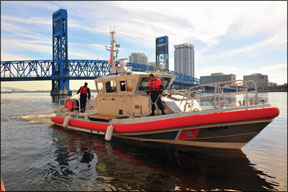
Photo courtesy of U.S. Coast Guard
Innocent cruisers who have been boarded by law enforcement often re-calibrate their assumptions about privacy and search-and-seizure laws. Even when masterfully carried out, an armed boarding team telling you to stand aside as they search your sailboat can be a little unnerving. I clearly recall an episode at sea when a member of a USCG boarding team caught the hammer of his holstered automatic under the lifeline, twanged it free and proved why it makes sense not to carry a round in the chamber. During this incident, my kids stood by as a young lieutenant informed us that his crew was going to search their cabin for Haitian stowaways. In short, even with the most courteous and professional of intrusions, you quickly realize that you have more rights in your car when youve been pulled over for doing 65 in a 40-mph traffic zone, than you do aboard a live-aboard sailboat.
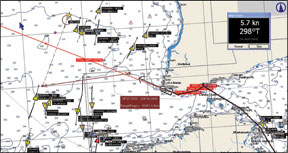
Photo courtesy of U.S. Coast Guard
The lingering question is how long will we be able to hang on to the limited rights we currently have, and the one currently in question is the right to selectively turn on or off an AIS transceiver, or for that matter, chose only a receiver or perhaps none at all. Collision statistics do not warrant mandating the equipment, but will the ever-growing tracking infrastructure and quest for security make universal compliance mandatory?
This decision is likely to be based upon the interplay between competing factors-on one hand, a perceived need for surveillance and security, and on the other, the right to freely navigate coastal waters. Scrutinizing the innocent in order to discover the guilty has gained traction without much congressional debate. It has become standard operating procedure despite constitutional conflict and challenges to prevailing views toward liberty. For many, whatever the effort, if it lessens the likelihood of another terrorist attack, its worth doing. Others are less willing to abdicate freedom and personal liberty. At present, a sailor has a choice in whether or not to become a blip on the AIS display.
But plans for NAIS-equipped satellites, surface ships, towers, and data buoys are on track; full scrutiny of the Maritime Domain will soon be a reality; and who will be tracked remains the big question. All it would take is one piece of legislation to make every vessel an MMSI-labeled blip on a nationwide network of security monitors. AIS will be the tracking engine, and turning on the unit could precede loosening up the dock lines. The real collision avoidance issue here is not only between vessels, but is one of philosophical values. On one side sit the advocates for freedom and liberty, and on the other those who favor security and safety at any cost.
After writing this opinion piece and contradicting my promise not to launch into a diatribe on the freedom to navigate, I hesitated to push Send. What changed my mind was a front-page article that appeared in my local newspaper announcing the launch of a camera- and radar-based scrutiny system for the Chesapeake Bay. The program is funded by USCG grants and is meant to make all boaters safer, add more protection to the environment, and lessen the threat from suspicious traffic-apparently NAIS is not enough. Perhaps these measures are warranted, but I can’t help thinking of Benjamin Franklins sage advice: Those who would give up essential liberty to purchase a little temporary safety, deserve neither liberty nor safety.






